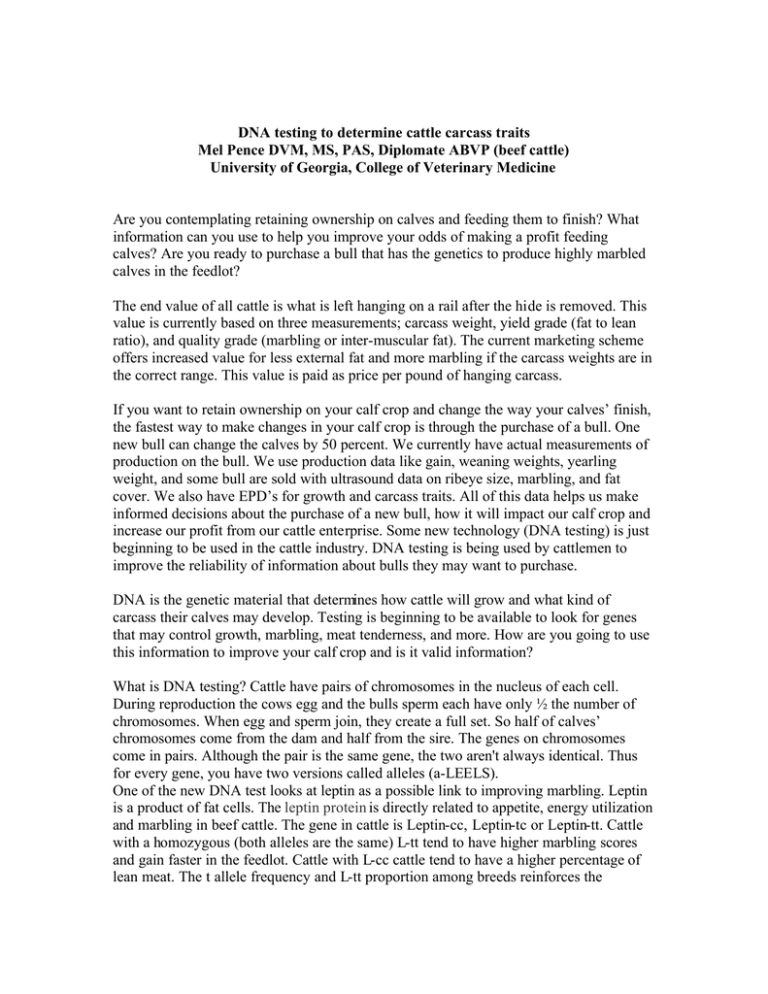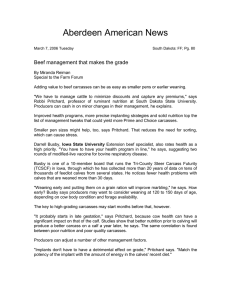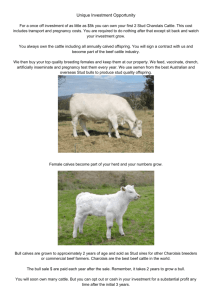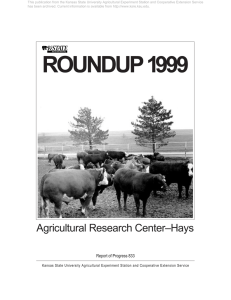DNA testing to determine cattle carcass traits
advertisement

DNA testing to determine cattle carcass traits Mel Pence DVM, MS, PAS, Diplomate ABVP (beef cattle) University of Georgia, College of Veterinary Medicine Are you contemplating retaining ownership on calves and feeding them to finish? What information can you use to help you improve your odds of making a profit feeding calves? Are you ready to purchase a bull that has the genetics to produce highly marbled calves in the feedlot? The end value of all cattle is what is left hanging on a rail after the hide is removed. This value is currently based on three measurements; carcass weight, yield grade (fat to lean ratio), and quality grade (marbling or inter-muscular fat). The current marketing scheme offers increased value for less external fat and more marbling if the carcass weights are in the correct range. This value is paid as price per pound of hanging carcass. If you want to retain ownership on your calf crop and change the way your calves’ finish, the fastest way to make changes in your calf crop is through the purchase of a bull. One new bull can change the calves by 50 percent. We currently have actual measurements of production on the bull. We use production data like gain, weaning weights, yearling weight, and some bull are sold with ultrasound data on ribeye size, marbling, and fat cover. We also have EPD’s for growth and carcass traits. All of this data helps us make informed decisions about the purchase of a new bull, how it will impact our calf crop and increase our profit from our cattle enterprise. Some new technology (DNA testing) is just beginning to be used in the cattle industry. DNA testing is being used by cattlemen to improve the reliability of information about bulls they may want to purchase. DNA is the genetic material that determines how cattle will grow and what kind of carcass their calves may develop. Testing is beginning to be available to look for genes that may control growth, marbling, meat tenderness, and more. How are you going to use this information to improve your calf crop and is it valid information? What is DNA testing? Cattle have pairs of chromosomes in the nucleus of each cell. During reproduction the cows egg and the bulls sperm each have only ½ the number of chromosomes. When egg and sperm join, they create a full set. So half of calves’ chromosomes come from the dam and half from the sire. The genes on chromosomes come in pairs. Although the pair is the same gene, the two aren't always identical. Thus for every gene, you have two versions called alleles (a-LEELS). One of the new DNA test looks at leptin as a possible link to improving marbling. Leptin is a product of fat cells. The leptin protein is directly related to appetite, energy utilization and marbling in beef cattle. The gene in cattle is Leptin-cc, Leptin-tc or Leptin-tt. Cattle with a homozygous (both alleles are the same) L-tt tend to have higher marbling scores and gain faster in the feedlot. Cattle with L-cc cattle tend to have a higher percentage of lean meat. The t allele frequency and L-tt proportion among breeds reinforces the traditional phenotypic differences between breeds, with the British breeds tending to marble and Continental breeds tending to be lean. Breed t Allele Frequency L-tt Proportion Angus 58% 30% Hereford 55% 32% Charolais 34% 10% Simmental 32% 10% The final 60 days on feed are the most critical for carcass quality. If you feed cattle long enough, nearly all of them will grade but it will not be cost-effective. What’s more, in an average group, animals that look identical when they are sorted will finish differently. Some of this difference is because of different leptin genotypes. When calves are homozygous L-tt they continue to stay in a hunger mode eating and storing fat, including intramuscular fat (marbling). These cattle finish sooner and have more marbling. Research has proven that if all other factors are equal, the leptin genotype has a significant impact on carcass quality. In a Texas trial of Charolais/Angus steers, only 11% of cattle identified as L-cc graded, while 62% of L-tt cattle earned grade. In a trial involving Hereford steers, no L-cc cattle graded, while 48% of L-tt cattle achieved grade. In a trial involving Charolais steers, the numbers grading were 38% and 58%, respectively for L-cc and L-tt cattle. So among each of the breeds there are certain individuals that have a higher likelihood of producing calves that will produce greater marbling. Now there is a DNA test to identify those likely higher marbling bulls. We can use this information to select high marling breeding stock if that is the goal we want for our calves. Higher leptin concentration means higher marbling and carcass quality. In 2003, a trial was conducted to determine if concentration of leptin could be used to predict carcass composition and merit in feedlot-finished cattle. This table shows that as serum leptin increases, marbling score also increase. Leptin Concentration and Marbling Group 1 Group 2 Leptin level 18.71 27.03 Marbling score 10.30 12.84 Fat cover 0.76 0.94 L-tt Genotype means higher carcass quality This table summarizes the results of a trial that quantifies the impact of leptin genotype on marbling. It clearly shows that cattle with the L-tt genotype finished with marbling scores 50% higher than those of L-cc cattle. Genetic type L-cc L-ct L-tt Marbling 0.76 0.87 1.13 Currently, there are two DNA carcass testing programs available to cattlemen. Merck is marketing a DNA leptin tests called IGENITY L and Genstar is marketing a DNA testing program called genstar-5. Both of these can be used to identify potential breeding stock that will produce more predictable carcass traits. The tests are done on hair samples are reasonably priced. Some breed associations are encouraging this testing. Beefmaster helps pay for some of this testing. You may want to look at using DNA testing to supplement the bulls information on growth and EPD’s when you look at your next bull purchase.






